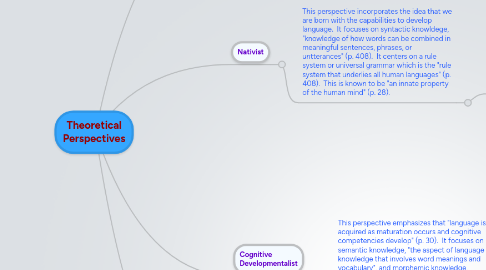
1. Behaviorist
1.1. This perspective is based on the idea that we are all born with a "blank slate" or nothing inborn, and that all the learning occurs "due to associations established between stimuli, responses, and events tha occur after the response behavior" (Otto, 2012, p. 31).
1.1.1. It focuses on semantic, syntactic, and morphemic knowledge which have to do with the combination of sentences. This is done by what is known as immative speech, "speech that approximates the speech of another person. Imitation may occur as a result of direct modeling or delayed modeling" (p. 406). Children will learn by what they hear their models (parents, siblings, teachers) say. Encouragement is how they will learn to repeat what they have already said.
1.1.1.1. Theorist: B. Skinner
2. Nativist
2.1. This perspective incorporates the idea that we are born with the capabilities to develop language. It focuses on syntactic knowldege, "knowledge of how words can be combined in meaningful sentences, phrases, or untterances" (p. 408). It centers on a rule system or universal grammar which is the "rule system that underlies all human languages" (p. 408). This is known to be "an innate property of the human mind" (p. 28).
2.1.1. "Children learn language by discoverning the structure of language", and is helped by " an inborn mechanism...for language" known as "language acquisition device LAD" (p. 29). Children use this mechanism by "constructing their knowledge of the ways language is used and manipulated" (p. 29).
2.1.1.1. Theorist: Noam Chomsky
3. Cognitive Developmentalist
3.1. This perspective emphasizes that "language is acquired as maturation occurs and cognitive competencies develop" (p. 30). It focuses on semantic knowledge, "the aspect of language knowledge that involves word meanings and vocabulary", and morphemic knowledge, "knowledge of word structure or how words are composed of one or more meaningful linguistic units" (p. 407).
3.1.1. Piaget has a theory that children go through stages which promts them to the learning process. First step is sensorimotor stage, the use of mortor functions in activities where they have the opportunity to touch, feel, and say what they see.
3.1.1.1. Theorist: Jean Piaget
4. Interactionist
4.1. This perspective has to do with social interaction and how children learn through this interactions. It focuses on pragmatic knowledge, "knowledge of the different ways in which language is used in different settings and for different purposes" (p. 407).
4.1.1. Children leanr language by their communication with those around them, how others use language, and for what they use it. In this perspective the environment plays a very important role in the language aquisition of the child.
4.1.1.1. Theorists: Lev Vygotsky, Jerome Bruner, and M. Halliday
